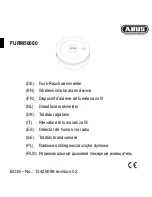
WHAT YOU SHOULD KNOW ABOUT CO
Carbon monoxide (CO) is an insidious poison. It is a colorless, odorless, tasteless gas. It is a
cumulative poison. Even low levels of CO have been shown to cause brain and other vital organ
damage in unborn infants with no effect on the mother.
The following symptoms are related to CARBON MONOXIDE POISONING and should be discussed
with ALL members of the household:
MILD EXPOSURE
Slight headache, nausea, vomiting, fatigue (often described as "flu-like" symptoms).
MEDIUM EXPOSURE
Severe throbbing headache, drowsiness, confusion, fast heart rate.
EXTREME EXPOSURE
Unconsciousness, convulsions, cardiorespiratory failure, death.
Many cases of reported CARBON MONOXIDE POISONING indicate that victims are aware they
are not well, but they become so disoriented that they are unable to save themselves by either
exiting the building or calling for assistance. Young children and household pets may be the first
affected.
Your combination alarm is designed to detect the toxic CO fumes that result from incomplete
combustion, such as those emitted from appliances, furnaces, fireplaces and auto exhaust.
What Levels of CO Cause an Alarm?
Underwriters Laboratories Inc. UL2034 defines three specific alarm points by which
all residential CO alarms must alarm. They are measured in parts per million (ppm) of
CO over time (in minutes).
UL2034 Required Alarm Points:
•
If the alarm is exposed to
400 ppm
of CO, IT MUST ALARM BETWEEN 4 and 15
MINUTES.
•
If the alarm is exposed to
150 ppm
of CO, IT MUST ALARM BETWEEN 10 and 50
MINUTES.
•
If the alarm is exposed to
70 ppm
of CO, IT MUST ALARM BETWEEN 60 and 240
MINUTES.
This product is intended for use in ordinary indoor locations of family living units. It is not designed
to measure compliance with Occupational Safety and Health Administration (OSHA) commercial or
industrial standards. Individuals with medical problems may consider using warning devices which
provide audible and visual warnings for carbon monoxide concentrations under 30 ppm.
IMPORTANT CONSIDERATIONS
YOUR COMBINATION SMOKE, CO AND NATURAL GAS ALARM HAS BEEN DESIGNED WITH
A PRODUCT END-OF-SERVICE LIFE SIGNAL WHICH WILL SOUND AFTER APPROXIMATELY
7 YEARS OF OPERATION FROM INITIAL POWER UP.
NOTE: MANUFACTURER RECOMMENDS REPLACEMENT OF THIS ALARM 7 YEARS AFTER
DATE OF INSTALLATION.
WHAT YOU SHOULD KNOW ABOUT NATURAL GAS
Natural gas is a fossil fuel which consists primarily of methane. This common energy source is often
used for cooking, home heating and water heating. Natural gas is typically supplied through a main
utility line connected to your home. It is a highly flammable chemical compound. Although it happens
rarely, a natural gas leak can sometimes occur inside the home. This can be dangerous because it
increases the risk of explosion and fire.
Natural gas is odorless and colorless. When Mercaptan is added to natural gas as an odorant, it can
then be detected by smell. Although it can vary greatly, the typical level for detection of the gas by
smell is 25% of the lower explosion limit (LEL). People who have a diminished sense of smell may
not be able to rely on this safety mechanism. Therefore, installation of this alarm can be an important
tool to help protect you and your family. This alarm is calibrated to sound before 20% LEL
Therefore,
it is possible that you may smell gas before the alarm is activated. If you are not sure which
gas your home uses, contact your utility company.
Page 3




































